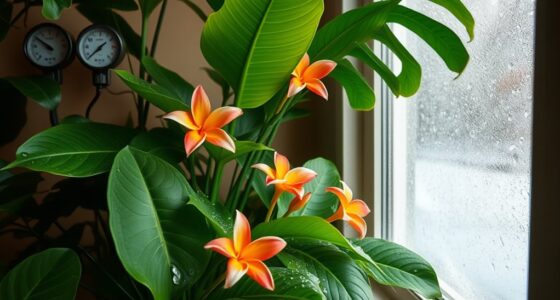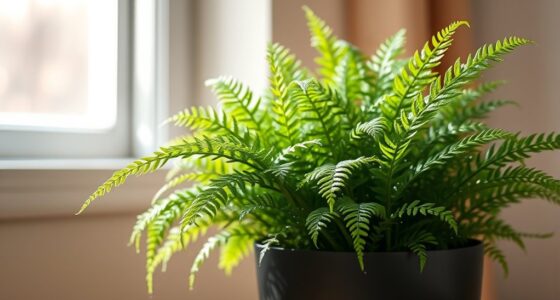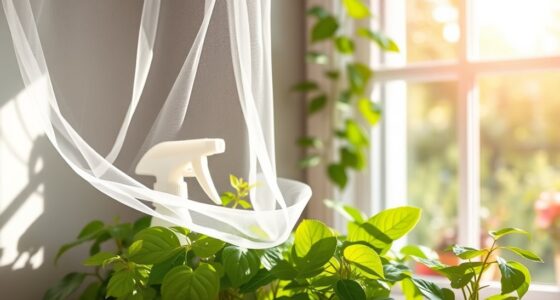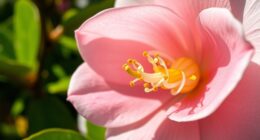The ZZ plant, or Zamioculcas zamiifolia, is the perfect low-maintenance houseplant because it’s almost impossible to kill, even if you forget to water it often. It thrives in low light and doesn’t need frequent watering—just water every 2-3 weeks and let the soil dry out completely. Its resilience and easy care make it ideal for busy or new plant owners. Continue exploring to discover how to keep your ZZ plant healthy and vibrant effortlessly.
Key Takeaways
- Requires infrequent watering, thriving with a simple schedule every 2-3 weeks, making it ideal for busy or forgetful plant owners.
- Tolerant of low light and neglect, thriving in various indoor environments with minimal fuss.
- Resilient to overwatering and pests, reducing maintenance and concern for plant health issues.
- Needs proper drainage and occasional leaf cleaning to prevent pests and ensure healthy growth.
- Enhances indoor spaces effortlessly with its striking, glossy foliage and minimal care requirements.

The ZZ plant, also known as Zamioculcas zamiifolia, is a popular indoor plant prized for its striking, glossy green leaves and low maintenance needs. Its resilience makes it ideal for beginners or anyone looking to add greenery without the fuss. One of the key reasons it’s so easy to care for is its forgiving watering schedule. Unlike many houseplants that require frequent attention, the ZZ plant prefers infrequent watering. You should allow the soil to dry out completely between waterings, which typically means watering every 2-3 weeks. Overwatering is a common mistake that can lead to root rot, so it’s better to err on the side of dryness. When you do water, give the plant a thorough soak until excess water drains from the pot’s bottom. Make sure your pot has proper drainage to prevent water from pooling at the roots. During winter, you can cut back on watering even further, as the plant’s growth slows down. Regularly inspecting the leaves and stems allows you to catch any pest issues early. If you notice tiny webs, sticky residue, or discolored spots, it’s time to act. Wiping the leaves with a damp cloth helps remove pests and their eggs. For stubborn infestations, insecticidal soap or neem oil works effectively without harming the plant. Good airflow and avoiding overwatering also contribute to pest prevention, as excess moisture and poor circulation create a hospitable environment for pests. Additionally, understanding proper soil conditions can help ensure your ZZ plant thrives and remains pest-free. The beauty of the ZZ plant lies in its simplicity; it doesn’t demand constant attention. With a proper watering schedule—allowing the soil to dry completely in between—and proactive pest prevention, you can enjoy a healthy, vibrant plant with minimal effort. Its tolerance for neglect, combined with its striking appearance, makes it a perfect addition to any space. Whether you’re in a busy household or a quiet office, the ZZ plant requires just enough care to thrive without overwhelming you. A little effort in monitoring watering and pests ensures your ZZ plant remains a lush, glossy focal point that brightens your environment effortlessly.
Frequently Asked Questions
Can ZZ Plants Be Toxic to Pets?
Yes, ZZ plants can be toxic to pets because they contain toxic ingredients that may cause irritation or more serious health issues if ingested. To keep your pet safe, you should place your ZZ plant out of their reach or consider choosing pet-safe houseplants. Always monitor your pets around plants and consult your veterinarian if you suspect they’ve consumed part of a ZZ plant.
How Often Should I Water My ZZ Plant?
Think of your ZZ plant as a wise old friend who doesn’t need frequent visits. You should water it about every 2-3 weeks, allowing the soil moisture to dry out completely between drinks. Keep an eye on the soil moisture—if it feels dry, it’s time to water. Overwatering can harm it, so it’s better to err on the side of dryness, letting the plant thrive with minimal fuss.
Is Direct Sunlight Harmful to ZZ Plants?
Direct sunlight can harm your ZZ plant, so you should avoid exposing it to intense, direct sunlight. Instead, position your plant in bright, indirect sunlight to promote healthy growth. Proper sunlight exposure is essential, but too much direct light can scorch its leaves. Find a spot near a window with filtered light or away from harsh sun rays. This way, your ZZ plant stays vibrant and healthy with minimal fuss.
What Pests Commonly Affect ZZ Plants?
You’ll find that common infestations like spider mites, mealybugs, and scale insects often target ZZ plants. To prevent pests, regularly inspect your plant and keep it healthy through proper watering and light. Pest prevention is key—use neem oil or insecticidal soap if you notice any pests early. Staying vigilant helps protect your ZZ plant from these pests, ensuring it stays vibrant and low-maintenance.
How Do I Propagate a ZZ Plant?
You can propagate a ZZ plant through leaf cuttings, division, or stem cuttings. For leaf cuttings, let the cuttings callus for a day, then plant them in well-draining soil. Division involves separating rhizomes with root development, ensuring each section has roots. Stem cuttings should be rooted in soil or water until roots develop. With patience, you’ll see new root development, leading to healthy, thriving plants.
Conclusion
The ZZ plant is your green guardian, quietly thriving while you focus on life’s chaos. With its glossy leaves like emerald shields, it’s the steadfast friend that never demands much but rewards you with vibrant life. Consider it your indoor oasis—a resilient soul that stands tall through neglect and busy days. Embrace the ZZ plant, and watch your home blossom with effortless elegance, turning even your busiest moments into a lush, calming retreat.










